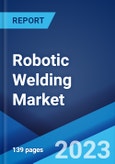Robotic welding, also known as automated welding, is a process of fusing two materials together using mechanized programmable instruments that heat, mix, and cool metal materials. It ensures that weld integrity is enhanced with consistent results for fast quality welds while reducing human errors, fatigue and distractions that may cause defects. As it helps in more accurate and precise welding, there are fewer scrap metals and wastes with robotic welding compared to manual welding. In addition, it performs different welding processes with less manpower and without the need for hiring additional staffing for production. As a result, it finds extensive applications in automotive, electronics, aerospace, defense, construction, and mining industries across the globe.
Robotic Welding Market Trends:
Due to reduced intensive labor injuries, improved order fulfilment speed and accuracy, and increased uptime with reduced costs, there is a rise in the utilization of robotic welding around the world. This, along with the growing demand for robotic welding to enhance the efficient use of working space and improve the supply chain performance in end-user industries, represents one of the key factors driving the market. Moreover, key market players are extensively investing in research and development (R&D) activities to improve the functions and benefits offered by robotic welding. This, coupled with the rising customization of robotic welding for several requirements, such as cloud-based operations and remote monitoring, along with effective physical stature for improved compatibility with the human workforce, is positively influencing the market. Additionally, the increasing employment of robotic welding in the automotive industry for resistance spot welding and arc welding in high production applications is offering lucrative growth opportunities to industry investors. Besides this, robotic welding requires minimal hard tooling as they are reprogrammable, which is projected to bolster the market growth.Market Segmentation:
This report provides an analysis of the key trends in each sub-segment of the global robotic welding market report, along with forecasts at the global, regional and country level from 2025-2033. The report categorizes the market based on type, payload, and end user.Breakup by Type:
Robotic Welding Market Report
- Spot Welding
- Arc Welding
- Others
Breakup by Payload:
- Less than 50 Kg
- 50-150 Kg
- More than 150 Kg
Breakup by End User:
- Automotive and Transportation
- Electrical and Electronics
- Metals and Machinery
- Others
Breakup by Region:
Robotic Welding Market Report
- North America
- United States
- Canada
- Asia-Pacific
- China
- Japan
- India
- South Korea
- Australia
- Indonesia
- Others
- Europe
- Germany
- France
- United Kingdom
- Italy
- Spain
- Russia
- Others
- Latin America
- Brazil
- Mexico
- Others
- Middle East and Africa
Competitive Landscape:
The competitive landscape of the industry has also been examined along with the profiles of the key players being ABB Ltd., Comau (Stellantis N.V.), DAIHEN Corporation, FANUC Corporation, Hyundai Robotics Co. Ltd. (Hyundai Heavy Industries Group), Kawasaki Heavy Industries Ltd., KUKA AG, Nachi-Fujikoshi Corp., Panasonic Corporation, Siasun Robot & Automation Co. Ltd. and Yaskawa Electric Corporation.Key Questions Answered in This Report
1. What was the size of the global robotic welding market in 2024?2. What is the expected growth rate of the global robotic welding market during 2025-2033?
3. What has been the impact of COVID-19 on the global robotic welding market?
4. What are the key factors driving the global robotic welding market?
5. What is the breakup of the global robotic welding market based on the type?
6. What is the breakup of the global robotic welding market based on the payload?
7. What is the breakup of the global robotic welding market based on the end user?
8. What are the key regions in the global robotic welding market?
9. Who are the key players/companies in the global robotic welding market?
Table of Contents
Companies Mentioned
- ABB Ltd.
- Comau (Stellantis N.V.)
- DAIHEN Corporation
- FANUC Corporation
- Hyundai Robotics Co. Ltd. (Hyundai Heavy Industries Group)
- Kawasaki Heavy Industries Ltd.
- KUKA AG
- Nachi-Fujikoshi Corp.
- Panasonic Corporation
- Siasun Robot & Automation Co. Ltd. and Yaskawa Electric Corporation.
Table Information
| Report Attribute | Details |
|---|---|
| No. of Pages | 149 |
| Published | May 2025 |
| Forecast Period | 2024 - 2033 |
| Estimated Market Value ( USD | $ 7.7 Billion |
| Forecasted Market Value ( USD | $ 14.3 Billion |
| Compound Annual Growth Rate | 7.1% |
| Regions Covered | Global |
| No. of Companies Mentioned | 10 |








